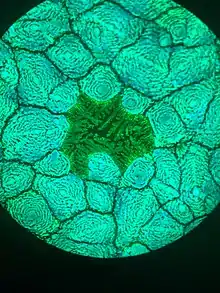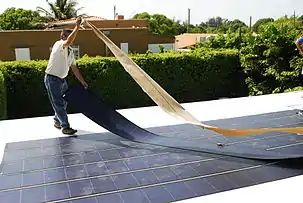David Ginger
David S. Ginger is an American physical chemist. He is the Alvin L. and Verla R. Kwiram endowed professor of chemistry at the University of Washington. He is also a Washington Research Foundation distinguished scholar, and Chief Scientist of the University of Washington Clean Energy Institute. In 2018 he was elected to the Washington State Academy of Sciences for his work on the microscopic investigation of materials for thin-film semiconductors.[1]
David Ginger | |
|---|---|
| Alma mater |
|
Education
Ginger has BS degrees from Indiana University Bloomington in Chemistry and Physics, and a PhD in Physics from the University of Cambridge, where his thesis advisor was Neil Greenham. He was a Marshall Scholar. After a joint NIH and DuPont Postdoctoral Fellowship at Northwestern University with Chad Mirkin, he joined the faculty of the University of Washington.[2]
Research
Electronic Materials for Solar Energy, Scanning probe microscopy, Plasmonics and Nanophotonics


Ginger specializes in the physical chemistry of materials with applications in energy, electronics, and sensing. His team has used combinations of optical and scanning probe microscopy to examine the properties of nanomaterials, particularly thin film semiconductors. The lab has studied mixed ionic/electronic transport materials such as those used in bioelectronics[3] batteries, and most notably in photovoltaic materials such as halide perovskites[4][5] and organic photovoltaics.[6]
References
- "David Ginger, Sotiris Xantheas elected to the Washington State Academy of Sciences | Department of Chemistry News". Retrieved 2019-05-27.
- https://depts.washington.edu/gingerlb/the-ginger-lab-group-members/david-s-ginger/
- Giridharagopal, R.; Flagg, L. Q.; Harrison, J. S.; Ziffer, M. E.; Onorato, J.; Luscombe, C. K.; Ginger, D. S. (July 2017). "Electrochemical strain microscopy probes morphology-induced variations in ion uptake and performance in organic electrochemical transistors". Nature Materials. 16 (7): 737–742. doi:10.1038/nmat4918. ISSN 1476-4660.
- de Quilettes, D. W.; Vorpahl, S. M.; Stranks, S. D.; Nagaoka, H.; Eperon, G. E.; Ziffer, M. E.; Snaith, H. J.; Ginger, D. S. (2015-05-08). "Impact of microstructure on local carrier lifetime in perovskite solar cells". Science. 348 (6235): 683–686. doi:10.1126/science.aaa5333. ISSN 0036-8075.
- deQuilettes, Dane W.; Frohna, Kyle; Emin, David; Kirchartz, Thomas; Bulovic, Vladimir; Ginger, David S.; Stranks, Samuel D. (2019-10-23). "Charge-Carrier Recombination in Halide Perovskites". Chemical Reviews. 119 (20): 11007–11019. doi:10.1021/acs.chemrev.9b00169. ISSN 0009-2665.
- Pingree, Liam S. C.; Reid, Obadiah G.; Ginger, David S. (2009). "Electrical Scanning Probe Microscopy on Active Organic Electronic Devices". Advanced Materials. 21 (1): 19–28. doi:10.1002/adma.200801466. ISSN 1521-4095.